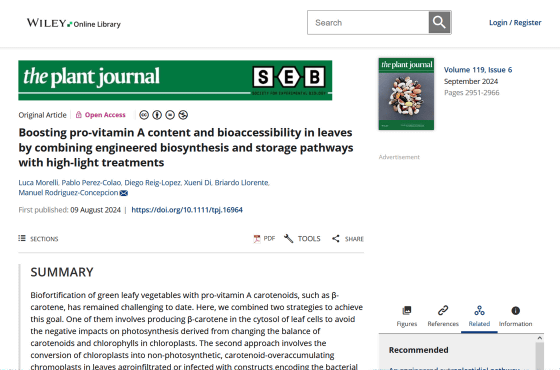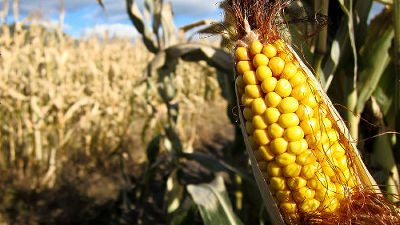Scientists create 'golden lettuce' with boosted vitamin A content

A research team from
Boosting pro‐vitamin A content and bioaccessibility in leaves by combining engineered biosynthesis and storage pathways with high‐light treatments - Morelli - 2024 - The Plant Journal - Wiley Online Library
https://onlinelibrary.wiley.com/doi/10.1111/tpj.16964

Noticia UPV: A team from the IBMCP (UPV-CSIC) has developed a technique that multiplies the beta-carotene content in plant leaves. | Universitat Politècnica de València
https://www.upv.es/noticias-upv/noticia-14794-superlechugas-en.html
Scientists Made a Golden Lettuce That Comes With a Vitamin Boost : ScienceAlert
https://www.sciencealert.com/scientists-made-a-golden-lettuce-that-comes-with-a-vitamin-boost
Vitamin A is an essential nutrient that plays a role in keeping the eyes, skin and mucous membranes healthy, and if it is deficient, it can cause problems such as visual impairments such as night blindness and increased risk of infection. Beta-carotene is a precursor to vitamin A and is usually found in abundance in carrots and spinach. However, a 2023 study found that vitamin A deficiency is particularly serious among low-income groups, adversely affecting the development of hundreds of millions of people around the world.
One approach that has attracted attention in efforts to combat hunger and malnutrition is 'biofortification,' which increases the amount of micronutrients contained in food. Although ' golden rice ' and potatoes rich in beta-carotene have already been developed through biofortification, it has been difficult to increase the beta-carotene content in leafy vegetables.
The reason it's difficult to increase the beta-carotene content in leafy vegetables is because carotenoids, including beta-carotene, are involved in photosynthesis in the chloroplasts, where photosynthesis takes place. 'Leaves need carotenoids like beta-carotene in the photosynthetic complexes of the chloroplasts to function properly,' says Manuel Rodríguez Concepción, a molecular biologist at CSIC. 'If the chloroplasts produce too much or too little beta-carotene, the chloroplasts stop functioning and the leaves die.'

The research team therefore set out to combine biotechnology techniques with high-intensity light irradiation to increase the production and accumulation of beta-carotene without affecting important processes such as photosynthesis.
The first approach was to use biotechnology to engineer a gene that encodes a biosynthetic
The second approach was to convert some chloroplasts into non-photosynthetic carotenoid hyperaccumulators, which led to the accumulation of high levels of beta-carotene in plastoglobules , which do not normally accumulate beta-carotene.
By combining the two approaches and growing the plants under 500W of high-intensity light, 10 times the normal light (50W), for three days, the amount of beta-carotene that was easily absorbed by the body increased by 30 times compared to normal conditions. 'Increasing the formation and development of plastoglobules using molecular techniques and intense light treatment not only increases the accumulation of beta-carotene, but also improves its bioaccessibility, i.e. it is more easily extracted from the food matrix and absorbed by the digestive tract,' said molecular biologist Luca Morelli, lead author of the paper.
The team tested the method on a model plant called Nicotiana benthamiana , and then applied it to edible romaine lettuce . When the treated lettuce was grown under high-intensity light, the beta-carotene content increased significantly, causing the leaves to turn yellowish. Due to this color, the lettuce was named 'golden lettuce.'

'By combining biotechnology techniques and high light treatment, our research has succeeded in producing and accumulating beta-carotene in cellular compartments where it is not normally present,' said Concepcion.
◆ Forum is currently open
A forum related to this article has been set up on the official GIGAZINE Discord server . Anyone can post freely, so please feel free to comment! If you do not have a Discord account, please refer to the account creation procedure article to create an account!
• Discord | 'Would you like to try the Vitamin A-enriched lettuce 'Golden Lettuce'? What kind of dishes would it go well with? ' | GIGAZINE
https://discord.com/channels/1037961069903216680/1290603716948529213
Related Posts:







